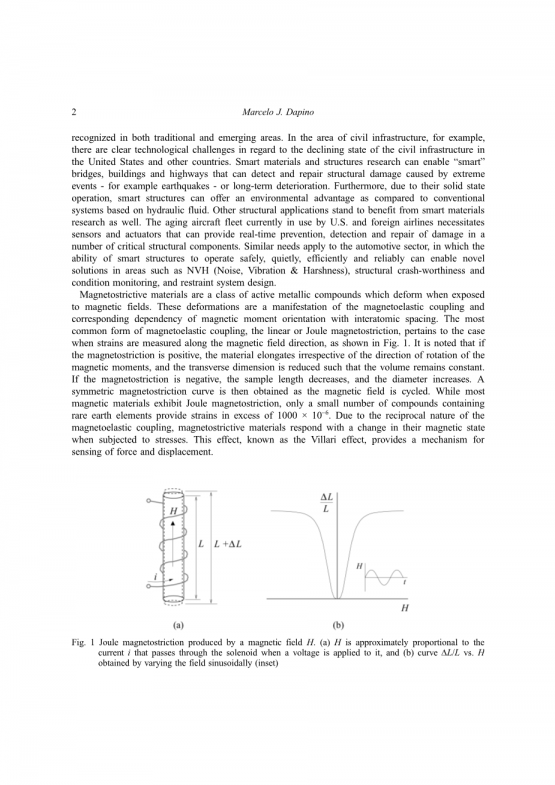

英语原文共 27 页
Structural Engineering and Mechanics, Vol. 17, No. 3-4 (2004) 000-000
On magnetostrictive materials and their use in adaptive structures
关于磁致伸缩材料及其在自适应结构中的应用
Marcelo J. Dapinodagger;
Department of Mechanical Engineering, The Ohio State University, 2091 Robinson Laboratory, Columbus, OH 43210-1107, USA
(Received , 2003, Accepted August 30, 2003)
Abstract. Magnetostrictive materials are routinely employed as actuator and sensor elements in a wide variety of noise and vibration control problems. In infrastructural applications, other technologies such as hydraulic actuation, piezoelectric materials and more recently, magnetorheological fluids, are being favored for actuation and sensing purposes. These technologies have reached a degree of technical maturity and in some cases, cost effectiveness, which justify their broad use in infrastructural applications. Advanced civil structures present new challenges in the areas of condition monitoring and repair, reliability, and highauthority actuation which motivate the need to explore new methods and materials recently developed in the areas of materials science and transducer design. This paper provides an overview of a class of materials that because of the large force, displacement, and energy conversion effciency that it can provide is being considered in a growing number of quasistatic and dynamic applications. Since magnetostriction involves a bidirectional energy exchange between magnetic and elastic states, magnetostrictive materials provide mechanisms both for actuation and sensing. This paper provides an overview of materials, methods and applications with the goal to inspire novel solutions based on magnetostrictive materials for the design and control of advanced infrastructural systems.
摘要:磁致伸缩材料通常用作各种噪声和振动控制问题中的致动器和传感器元件。在基础设施应用中,诸如液压致动,压电材料以及最近的磁流变流体之类的其他技术正被用于致动和感测目的。这些技术已达到一定程度的技术成熟度,在某些情况下还具有成本效益,这证明了它们在基础设施应用中的广泛应用。先进的土木结构在状态监测和修复,可靠性和高强度驱动方面提出了新的挑战,这激发了探索最近在材料科学和换能器设计领域开发的新方法和材料的需求。本文概述了一类材料,由于它可以提供大的力,位移和能量转换效率,正在越来越多的准静态和动态应用中考虑。由于磁致伸缩涉及磁性和弹性状态之间的双向能量交换,因此磁致伸缩材料提供用于致动和感测的机制。本文概述了材料,方法和应用,旨在激发基于磁致伸缩材料的新型解决方案,用于设计和控制先进的基础设施系统。
Key words:
关键词:
Introduction
1介绍
An adaptive or smart structure consists of four main elements: actuators, sensors, control strategies, and power electronics (Chopra 2002, Garg et al. 2002). A smart structure responds to changing external conditions - e.g., loads or deformations - as well as internal conditions - e.g., damage or failure. Microprocessors analyze the responses from the sensors in real or nearly real time and use integrated control theory to command the actuators to apply localized deflections and forces. These inputs effect changes in the structure which counteract or otherwise modify system response in a controlled manner. Numerous applications of smart structures to physical systems are evolving to actively control vibration, noise, damping, shape change, stress distribution, and even microscopic properties (Kessler et al. 2003).
自适应或智能结构由四个主要元素组成:执行器,传感器,控制策略和电力电子(Chopra 2002,Garg等2002)。 智能结构响应于变化的外部条件 - 例如负载或变形 - 以及内部条件 - 例如损坏或故障。 微处理器实时或近乎实时地分析来自传感器的响应,并使用集成控制理论来命令致动器施加局部偏转和力。 这些输入影响结构的变化,从而以受控的方式抵消或以其他方式修改系统响应。 智能结构在物理系统中的众多应用正在发展,以主动控制振动,噪声,阻尼,形状变化,应力分布,甚至微观特性(Kessler等,2003)。
The benefits of smart structures as compared with passive or conventional structures have been
recognized in both traditional and emerging areas. In the area of civil infrastructure, for example, there are clear technological challenges in regard to the declining state of the civil infrastructure in the United States and other countries. Smart materials and structures research can enable “smart” bridges, buildings and highways that can detect and repair structural damage caused by extreme events - for example earthquakes - or long-term deterioration. Furthermore, due to their solid state operation, smart structures can offer an environmental advantage as compared to conventional systems based on hydraulic fluid. Other structural applications stand to benefit from smart materials research as well. The aging aircraft fleet currently in use by U.S. and foreign airlines necessitates sensors and actuators that can provide real-time prevention, detection and repair of damage in a number of critical structural components. Similar needs apply to the automotive sector, in which the ability of smart structures to operate safely, quietly, efficiently and reliably can enable novel solutions in areas such as NVH (Noise, Vibration amp; Harshness), structural crash-worthiness and condition monitoring, and restraint system design.
与被动或传统结构相比,智能结构的好处已经在传统和新兴领域都得到认可。例如,在民用基础设施领域,美国和其他国家的民用基础设施状况下降存在明显的技术挑战。智能材料和结构研究可以实现“智能”桥梁,建筑物和高速公路,可以检测和修复由极端事件(例如地震)或长期恶化引起的结构损坏。此外,由于其固态操作,与基于液压流体的传统系统相比,智能结构可提供环境优势。其他结构应用也将从智能材料研究中受益。目前美国和外国航空公司正在使用的老化飞机机队需要能够在许多关键结构部件中提供实时预防,检测和修复损坏的传感器和致动器。类似的需求也适用于汽车行业,其中智能结构安全,安静,高效和可靠地运行的能力可以在NVH(噪音,振动和粗糙),结构碰撞和状态监测等领域实现新颖的解决方案,以及约束系统设计。
Magnetostrictive materials are a class of active metallic compounds which deform when exposed to magnetic fields. These deformations are a manifestation of the magnetoelastic coupling and corresponding dependency of magnetic moment orientation with interatomic spacing. The most common form of magnetoelastic coupling, the linear or Joule magnetostriction, pertains to the case when strains are measured along the magnetic field direction, as shown in Fig. 1. It is noted that if the magnetostriction is positive, the material elongates irrespective of the direction of rotation of the magnetic moments, and the transverse dimension is reduced such that the volume remains constant. If the magnetostriction is negative, the sample length decreases, and the diameter increases. A symmetric magnetostriction curve is then obtained as the magnetic field is cycled. While most magnetic mater


